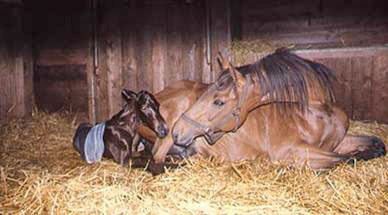 After months of anxiously waiting, your foal is finally here. But with the arrival of your little one comes a whole new list of worries. What if my foal gets sick and how do I know when something is wrong? In this column we will discuss a few of the more common conditions affecting young foals, what to watch for, and what treatments may be needed.
After months of anxiously waiting, your foal is finally here. But with the arrival of your little one comes a whole new list of worries. What if my foal gets sick and how do I know when something is wrong? In this column we will discuss a few of the more common conditions affecting young foals, what to watch for, and what treatments may be needed.
Hernias
Umbilical hernias are typically congenital and the majority of the time they represent a purely cosmetic defect. However, they can become a life-threatening emergency if bowel becomes entrapped in the hernia sac. If the hernia becomes painful, the foal shows signs of colic, or the hernia cannot be manually reduced easily (contents pushed back up into the abdomen), contact your veterinarian as soon as possible. An umbilical hernia that is easily reduced and is less than about 5 cm in diameter will often close on its own as the foal grows. If, however, the hernia is still present once the foal is four months of age or older, surgical closure should be considered.
Scrotal hernias (also known as inguinal hernias) in colts are usually congenital and are typically hereditary. They occur when the structures that the spermatic cord and testicle pass through from the abdomen to the scrotum are unusually large. They can occur on one or both sides and can typically be manually reduced easily. They are not usually a medical emergency, however it is possible for intestine to become entrapped in the hernia. When this occurs, the colt will show signs of colic. This represents an emergency and your veterinarian should evaluate the animal immediately. Surgery is usually necessary to reduce the hernia and remove any compromised intestine that has become devitalized during strangulation. Uncomplicated inguinal/scrotal hernias often resolve spontaneously between three and six months of age. If they do not resolve on their own, surgical correction (ideally in conjunction with castration to help prevent recurrence) is indicated.
 Umbilical Abnormalities
Umbilical Abnormalities
The urachus is a normal embryonic structure that allows urine to pass from the bladder to the allantoic cavity during gestation. This structure normally closes at birth. When it does not close, however, the umbilicus will be persistently wet and will drip or leak a steady stream of urine. These signs can also occur with umbilical infection and a resulting acquired patent urachus. A patent urachus can close on its own over time with medical treatment only. Medical treatment consists of navel dips with dilute chlorhexidine solution +/- antibiotics if any evidence of infection is present (or prophylactically to prevent development of infection, which is common). If umbilical infection is present and/or the patent urachus is not resolving with medical treatment, surgical removal of the umbilicus and associated structures (with closure of the attached bladder apex) is indicated. Externally, an infected umbilicus will typically be swollen and will often have purulent discharge and be painful on palpation.
Joint Infection
Umbilical infection, with or without development of a patent urachus, is a very concerning condition in young foals. Infection of the umbilical structures can spread to infection in one or more joints. Neonatal foals with failure of passive transfer (inadequate transfer of immunity from the mare) are at particularly high risk for development of infection in synovial structures and/or bone from generalized systemic infection and/or umbilical infection. Any evidence of lameness or joint swelling in a young foal is cause for concern, and the foal should have veterinary evaluation as soon as possible. The larger joints (hock and stifle) are most commonly affected, but these infections can occur in any joint. If lameness and joint swelling develop, radiographs should be taken to evaluate the integrity of the bone itself (to evaluate for infection that has spread to the bone), and a sample should be taken from any affected joint or joints to evaluate for infection of the joint. If infection is present, surgery is necessary to lavage the joint and debride any affected bone, followed by treatment with systemic and local antibiotics. When infection is severe, multiple surgeries may be needed and the prognosis, particularly for performance, may be poor.
Megan Williams graduated from Kansas State University and went on to an internship at Ocala Equine Hospital. She completed her surgical residency at Michigan State University. Dr. Williams is a surgeon at Saginaw Valley Equine Clinic and a lameness diagnostician with GameTime Sports Medicine at major AQHA events around the country. You can email her at megan@saginawvalleyequine.com or visit her at www.saginawvalleyequine.com.


You must be logged in to post a comment Login